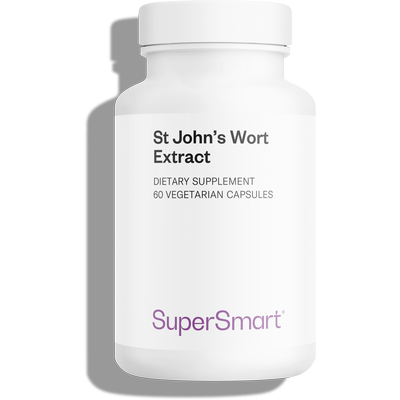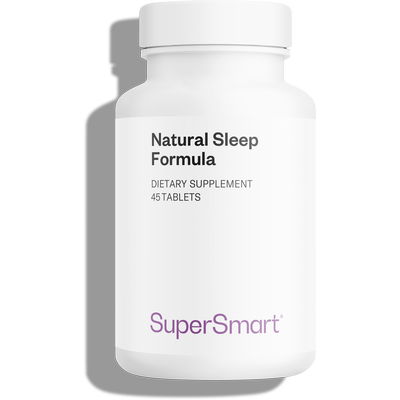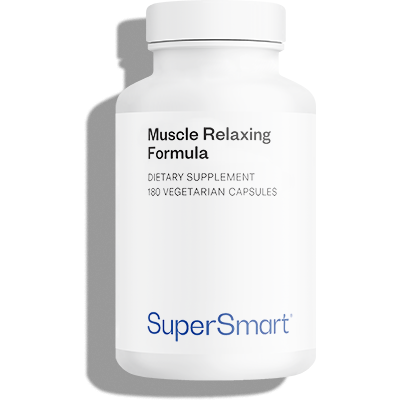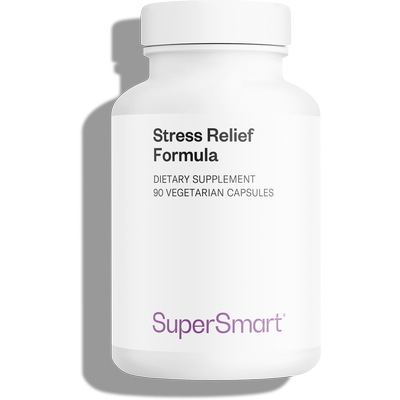What are the 7 best natural anxiolytics?
Many people are looking for natural alternatives to prescription drugs when it comes to relieving stress and anxiety. Here we focus on the 7 most effective natural anxiolytics.

What is an anxiolytic?
An anxiolytic is a substance used for treating or relieving pathological anxiety and associated disorders such as stress, depression, tension and insomnia .
Etymologically, the word comes from ‘anxio’ meaning ‘worried’ and ‘lytic’ meaning ‘to break down’. In terms of medication, ‘anxiolytic’ is reserved for tranquillisers from the benzodiazepine family, but in a broader sense, the term may refer to relaxing products in general, some of which are 100% natural.
To help relieve anxiety disorders (generalised, social and separation anxiety; panic; phobias such as agoraphobia …), we have listed below the 7 best natural anxiolytics - plants which are effective and obtainable without a prescription - as well as their mode of action.
1) Linden, the ‘anti-burnout’ plant
An adaptogen par excellence, linden helps to reduce nervous tension, instability and irritability. It’s known for its honey (with the most delicate of flavours) and the sweet-scented teas made from it.
Mechanism of action: linden’s antispasmodic and sedative effects come from its volatile oils (eugenol and limonene) which have mild tranquillising and anaesthetic properties, its p-coumaric acid which reduces inflammation, and its many flavonoids, which work by inhibiting the enzyme that breaks down serotonin (the ‘happiness hormone’) (1).
Mode of use: ready-to-use herbal teas, homemade infusions (2 grams of linden flowers in 150ml of boiling water) and linden flower baths.
2) Passionflower, the tropical vine for easing agitation
A climbing plant highly-prized in the Native American pharmacopoeia, passionflower induces a state of calm which reduces psychomotor agitation. It is traditionally used for alleviating withdrawal-induced anxiety and cerebral excitation.
Mechanism of action: passionflower’s properties come from 3 synergistic chemical groups, flavonoids, y-pyrone derivatives, and harman-group alkaloids, which are thought to act on the same receptors as those of benzodiazepines (2).
Mode of use: herbal teas, homemade infusions (a spoonful of dried leaves or flowers per 150ml of water, two or three times a day, including before bed) and passionflower supplements (or anti-stress formulations that contain it such as (Stress Relief Formula).
3) Lemon balm, aka ‘bee balm’, with soothing properties
A ubiquitous ingredient in relaxing teas, lemon balm promotes optimal relaxation and drowsiness. It helps to maintain a positive mood and good cognitive function.
Mechanism of action: lemon balm’s volatile oils (citral, citronellal, limonene, pinene, geraniol…) are believed to act on a part of the brain that oversees autonomic functions, and in particular on certain receptors of the central nervous system (3-4).
Mode of use: in addition to ready-to-use herbal teas, you can make homemade infusions (by picking wild lemon balm and infusing 3g of dried leaves in 150ml of boiling water), or use essential oil of lemon balm (a few drops on the temples or in a foaming bath), or take a lemon balm supplement (or a relaxing formulation that contains it such as Muscle Relaxing Formula, targeted at muscle stiffness).
4) Valerian, an aid to a peaceful night’s sleep
Also known as ‘cat’s love’, valerian helps to promote sleepiness and maintain a natural sleep (5). It’s also recommended for psychological and sensory overexcitability.
Mechanism of action: it’s not valerenic acid, responsible for the plant’s heady scent, which is behind its effects, but borneol ethers, alkaloids and glucosides. Together, they are thought to act on the central nervous system.
Mode of use: herbal teas, homemade macerations (10g of dried root steeped in 250ml of cold water for a day) and valerian supplements (or sleep-promoting formulations that contain it such as Natural Sleep Formula), usually taken before bed and for short periods.
5) St John’s Wort, the quintessential mood-enhancing plant
Renowned for its ability to maintain a positive mood, St John’s Wort is also good for relaxation and for promoting healthy sleep patterns. It is frequently compared with tricyclic antidepressants for combatting mild to moderate symptoms of depression (6).
Mechanism of action: hypericin and hyperforin are its two main active ingredients. They help increase the availability of serotonin and GABA (a relaxation neurotransmitter) in the central nervous system by inhibiting their reuptake. Other ingredients also contribute to its effects, including flavonoids (quercetin, biapigenin, mequilianin...) and volatile oils.
Mode of use: herbal teas, mother tinctures and extracts standardised in hypericin and/or hyperforin (such as St John's Wort Extract).
6) Lavender, the crown jewel of relaxing aromatherapy
Prized by the Romans for its soothing and antimicrobial properties when added to thermal baths, lavender (Lavandula angustifolia) is a significant aid to calmness and relaxation.
Mechanism of action: essential oil of lavender (marked in particular by limonene and perillyl alcohol) is believed to reduce certain psychological markers of stress, such as cortisol levels and blood pressure (7).
Mode of use: infusions of dried flowers (a spoonful of dried flowers in 150ml of water), mother tinctures, essential oils (a few drops on the forearms and solar plexus, or inhaled from a large bowl of boiling water, or added to a warm bath before bed) and supplements (such as the combination of soothing essential oils Organic Relaxing Oil Blend).
7) California poppy, the gold-standard for stress and anxiety discomfort
Long-used by Native Americans for its calming properties, California poppy, or eschscholzia, supports relaxation, helps to relieve mild stress symptoms and improves the quality of natural sleep.
Mechanism of action: California poppy acts on the central nervous system as a result of benzodiazepine-like properties. We don’t yet know whether these effects are due to a few compounds in particular (several alkaloids including protopine and benzophrenanthridine are thought to play a key role) or to the synergy of all its ingredients (8).
Mode of use: given its very bitter taste, infusions are too unpalatable to be recommended. In addition, the alkaloids responsible for its anxiolytic effects are not water-soluble, which reduces their efficacy. Better options are mother tinctures and supplements (such as the formulation Natural Sleep Formula, mentioned above, which is specifically designed to help restore restful sleep).
SUPERSMART ADVICE
References
- Gomez Pinilla F. Natural mood foods: the actions of polyphenols against psychiatric and cognitive disorders. Nutr Neuro Sci 2012; 15(3):127-133.
- Ségolène Frantz. Activité anxiolytique de molécules d’origine naturelle: contribution à l’étude du kawa, du millepertuis et de l’eschscholtzia. Sciences pharmaceutiques. 2001. ffhal-01733539
- Kennedy DO, Wake G, et al. Modulation of mood and cognitive performance following acute administration of single doses of Melissa officinalis (Lemon balm) with human CNS nicotinic and muscarinic receptor-binding properties. 2003 Oct;28(10):1871-81.
- Pharmacological profile of an essential oil derived from Melissa officinalis with anti-agitation properties: focus on ligand-gated channels. Abuhamdah S, Huang L, et al. J Pharm Pharmacol. 2008 Mar;60(3):377-84.
- Bent S, Padula A, Moore D, et al: Valerian for sleep: a systematic review and meta-analysis. Am J Med 119(12):1005–1012, 2006. doi: 1016/j.amjmed.2006.02.026
- Apaydin EA, Maher AR, Shanman R, et al: A systematic review of St. John's wort for major depressive disorder. Systematic Reviews 5:148, 2016. doi: 10.1186/s13643-016-0325-2
- Woronuk et al. Biosynthesis and therapeutic properties of Lavandula essential oil constituents. Planta Med. 2011 Jan;77(1):7-15.
- ROLLAND A., FLEURENTIN J., LANHERS M.C., YOUNOS C., MISSLIN R., MORTIER F., PELT J.M. Behavioural effects ofthe american traditional plant Eschscholtzia californica: sedative and anxiolytic properties. Planta medica, 1991, 57, P 212-216.
Keywords
4 Days
Delivery is prompt and I never saw a…
Delivery is prompt and I never saw a quality problem with the manufacturing. It is not possible to assess efficacy on a personal basis, since too many factors come into play. Efficacy can only be assessed statistically with a sufficient number of cases.
Roger De Backer
5 Days
I collaborates with the Supersmart…
I collaborates with the Supersmart more than 10 years. Every thing is going good. Quality of the things is good. Delivery comes in time. Five stars definitely !!!
Oleksiy
5 Days
All good
Simple, frictionless site, easy ordering, good delivery updates and execution.
Chris Robbins
7 Days
I feel better
I feel better
Peter Ammann
7 Days
Prompt delivery
Prompt delivery
JAKUB Radisch
8 Days
My new go-to for top quality supplements!
I am buying more and more of my supplements from this superb, high quality company. Cannot recommend it enough. Plus, excellent customer service with a quick, helpful team and speedy deliveries. Highly recommend Supersmart!
Cecilie H.
12 Days
SUPERSMART WHAT ELSE👍
SUPERSMART WHAT ELSE👍
DIEDERLE Christophe
15 Days
Excellent quality products with…
Excellent quality products with innovative formulas, as someone who has been suffering with acid reflux, these supplements have been lifesavers.
Oriana Moniz
15 Days
high quality supplement!
high quality supplement!
GALANT
16 Days
Good service prompt delivery
Good service prompt delivery
Mrs Marcella Reeves
21 Days
I like your clear explanation
I like your clear explanation. And how to make a choice of products for a specific health problem
Ingrid
27 Days
Great product and it arrives quickly.
Great product and it arrives quickly.
SOMMARIVA Gianni
28 Days
Excellent products and fast service.
Excellent products and fast service. What do we need more?
Margarida
32 Days
The variety of products is amazing
The variety of products is amazing, the offers are good and the sending is very fast. I just miss having a bit more of guidance about combinations, possible interactions, etc.
Maria Angeles Verdu
34 Days
It was quick
It was quick.
Timo Antero









